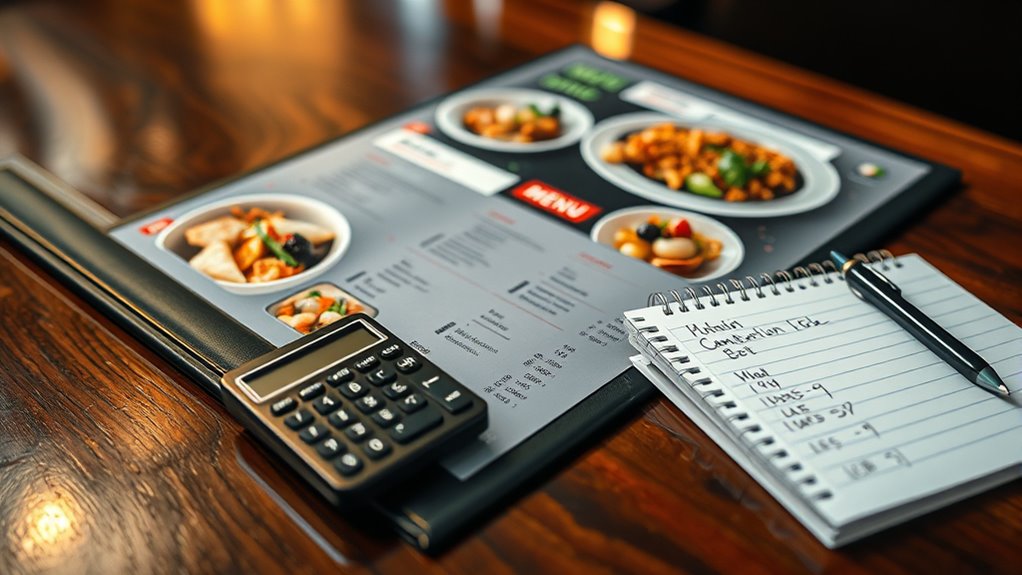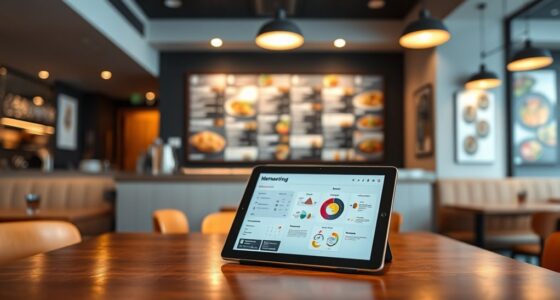Contribution margin in menu pricing shows how much each dish helps cover fixed costs and generate profit after subtracting variable expenses like ingredients and labor. It indicates the true profitability of an item before considering overhead costs. By understanding this, you can identify which dishes are most profitable and adjust prices or ingredients accordingly. Keep exploring to discover how this insight can transform your menu strategy and boost your restaurant’s success.
Key Takeaways
- Contribution margin is the difference between a dish’s selling price and its variable costs.
- It indicates how much each menu item contributes to covering fixed costs and profit.
- Calculated by subtracting ingredients, labor, and fluctuating expenses from the dish price.
- Helps identify which menu items are most profitable and supports strategic pricing decisions.
- Essential for menu engineering, enabling restaurants to optimize offerings for maximum profitability.

Understanding contribution margin is essential when it comes to setting effective menu prices. It helps you determine how much money each dish contributes to covering your fixed costs and generating profit. When you perform a thorough cost analysis, you’re able to identify which menu items are truly profitable and which ones may be dragging down your margins. This process is a key component of menu engineering, where you strategically design your menu to maximize profitability. By analyzing contribution margins, you can make more informed decisions about pricing, portion sizes, and the placement of dishes on your menu.
Contribution margin reveals how each dish impacts your restaurant’s profitability.
Contribution margin is calculated by subtracting the variable costs associated with a dish from its selling price. Variable costs include ingredients, direct labor, and other expenses that fluctuate with sales volume. Once you know this figure, you gain insight into the actual profit generated by each item before accounting for fixed costs like rent and salaries. This information is crucial because it highlights which dishes are worth promoting and which might need reworking or removal. You might discover that a seemingly popular item has a low contribution margin, meaning it’s not as profitable as it appears, especially if its ingredient costs are high relative to its selling price.
In your menu engineering efforts, understanding contribution margin allows you to classify dishes into categories such as stars, plowhorses, puzzles, and dogs. Stars have high contribution margins and high popularity; these are the items you should promote. Plowhorses are popular but have low margins, so you might consider increasing their prices or reducing costs. Puzzles are less popular but generate high margins, making them candidates for targeted marketing. Dogs are neither popular nor profitable, so they’re prime candidates for removal or re-evaluation. This strategic segmentation helps you optimize your menu for maximum profitability.
Furthermore, knowing the contribution margin guides you in adjusting prices to improve overall profitability without alienating customers. When you consider cost analysis in tandem with contribution margins, you’re better equipped to make pricing decisions that balance competitiveness with profit goals. For example, small price increases on high-margin items can substantially boost your bottom line without sacrificing sales volume. Conversely, you may find opportunities to reduce ingredient costs or improve portion control on lower-margin dishes, enhancing their contribution margins.
Additionally, analyzing the profitability of individual menu items helps you identify potential for upselling and bundling strategies that can increase overall revenue. In essence, understanding contribution margin empowers you to take a data-driven approach to menu pricing. It’s a fundamental aspect of menu engineering that ensures each dish contributes as much as possible to your financial health. By regularly analyzing these margins, you stay agile and can adapt your offerings to maximize profitability, ensuring your restaurant remains competitive and financially sustainable.
Frequently Asked Questions
How Does Contribution Margin Affect Overall Restaurant Profitability?
You can boost your restaurant’s profitability by understanding how contribution margin impacts your bottom line. It helps you identify which menu items generate the most profit after costs, guiding your profitability analysis and menu optimization. By focusing on high-margin dishes, you reduce losses and increase overall profitability. Monitoring contribution margin regularly guarantees you make informed decisions, optimize pricing, and improve your restaurant’s financial health effectively.
What Are Common Mistakes When Calculating Contribution Margin?
Think of these calculation pitfalls as landmines in your pricing strategy. You often make pricing errors by forgetting to include all variable costs or misallocating fixed costs, which skews your contribution margin. Avoid common mistakes like using outdated data or ignoring overheads. To stay safe, double-check your data, stay consistent, and always update your calculations to reflect current costs. This approach helps prevent costly errors that can harm your profitability.
How Can Contribution Margin Guide Menu Pricing Strategies?
You can use contribution margin to guide your pricing strategies by identifying which menu items bring in the most profit. Focus on optimizing your menu by promoting high-margin dishes and adjusting prices for lower-margin ones. This approach helps you maximize profitability, improve menu balance, and make informed decisions about item placement and special offers, ultimately leading to better menu optimization and increased revenue.
Does a Higher Contribution Margin Always Mean Better Menu Items?
Did you know that restaurants with higher contribution margins often see up to 20% better profitability? A higher contribution margin doesn’t always mean a better menu item; it’s just one profitability metric. When focusing on menu optimization, you should consider customer preferences and sales volume alongside contribution margins. This balanced approach helps guarantee your menu offers both popular and profitable options, maximizing overall success.
How Often Should a Restaurant Review Its Contribution Margin?
You should review your contribution margin regularly, ideally monthly or quarterly, to stay responsive to seasonal adjustments and supplier discounts. These factors can impact costs and profitability, so frequent reviews help you identify which menu items are still profitable. By monitoring these margins consistently, you can make informed pricing decisions, adjust for seasonal changes, and capitalize on supplier discounts, ensuring your menu remains profitable and competitive.
Conclusion
Now that you understand contribution margin in menu pricing, you can confidently craft cost-conscious, competitive, and profitable menus. By balancing benefits and costs, you ensure your business blooms beyond basic breakeven. Remember, mastering margins means measuring, managing, and maximizing your menu’s success. With clear calculations and careful considerations, you’ll create a compelling, consistent culinary cash flow. Stay savvy, stay strategic, and watch your profits flourish through smart, savvy menu pricing!









